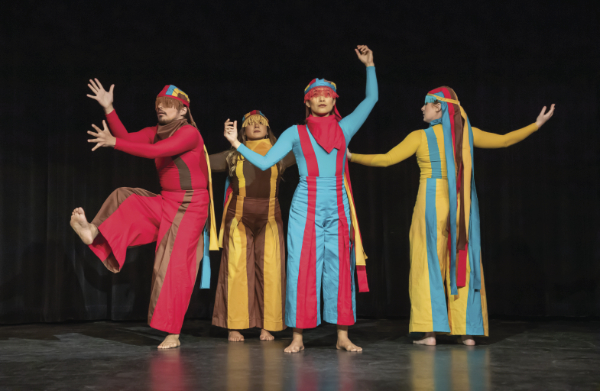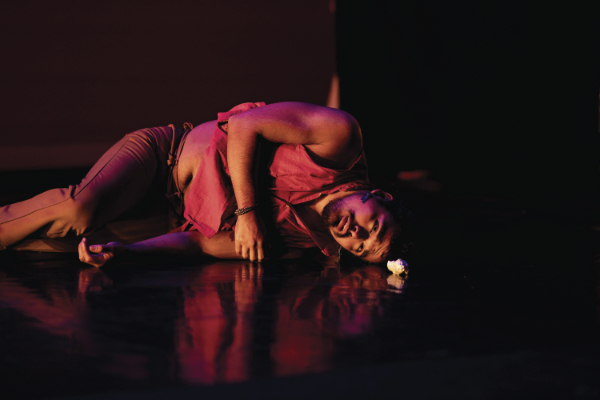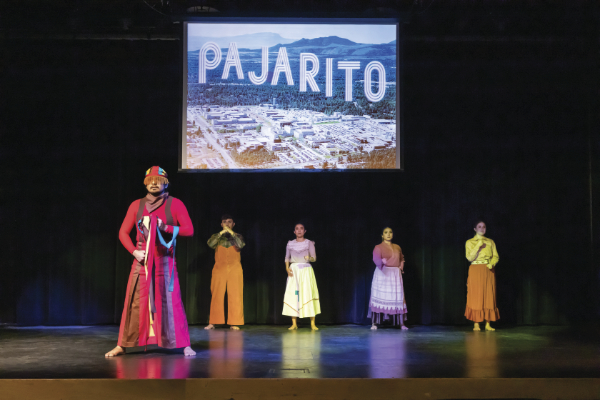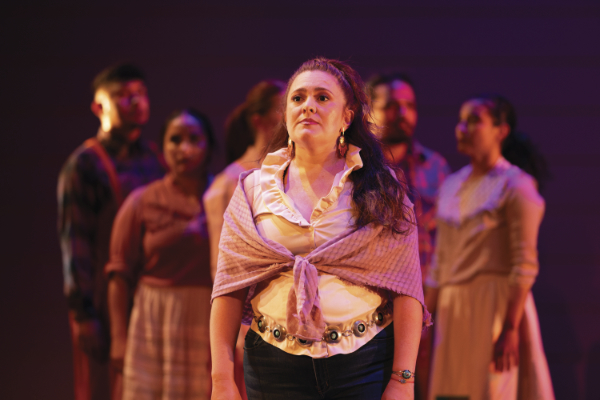“¿Tecolote d’ónde vienes?”
Preserving Querencia through Dance in Stories from Home
 “Tecolote” dance from Stories from Home,
performed by dancers Esteban Rosales, Luz Zarina
Mendoza Orduño, and Ruby Morales, 2023.
Photograph by Dominic AZ Bonuccelli, courtesy of
Yvonne Montoya.
“Tecolote” dance from Stories from Home,
performed by dancers Esteban Rosales, Luz Zarina
Mendoza Orduño, and Ruby Morales, 2023.
Photograph by Dominic AZ Bonuccelli, courtesy of
Yvonne Montoya.
By Myrriah Gómez
Four dancers take the stage. Their headpieces cast a striking resemblance to the headdresses of los soldados from the tradition of Los Matachines. Long colorful ribbons flutter down their backs and fringe covers their eyes. The vocals of Lia Martinez, Jordan Wax, and Shae Fiol of Lone Piñon hauntingly narrate the movement of messenger birds on stage with the opening words: “¿Tecolote d’ónde vienes?” or “Where do you come from, little owl?” A keen eye will quickly notice the contrast of brown bodies against brightly colored costumes. Their movements alternate between recognizable nuevomexicano folk dance movements and Western Contemporary and Modern dance. It’s mesmerizing until you are startled out of your trance when one of the tecolotes (danced by original cast member Ruby Morales) becomes injured. Slowly, the tecolote moves to lie down on the floor. At the close of the dance, viewers are left wondering what happens to the dead bird.
“Tecolote” is the opening number for nuevomexicana choreographer Yvonne Montoya’s Stories from Home, a collection of dances that embodies the cultural tradition of storytelling in Northern New Mexico. The performance is comprised of two acts. Act One includes five dances, and Act Two contains four. The dances tell stories of herencia sefardí, mestizo and genízaro; linguistic terrorism; the bracero program; the Manhattan Project; family secrets; a borderlands love story; and motherhood. The stories were inspired by Montoya’s father and created for her son, yet the historias depicted are relatable for all nuevomexicanos.
In New Mexican Spanish, a tecolotitois a little owl, and in nuevomexicano culture, tecolotes are messengers between life and death. When Montoya’s father was diagnosed with stage 4 cancer in 2011, an owl began to roost in a tree in front of her home in Tucson, Arizona, where she lives with her husband and son. She noticed that it began to follow her. Once, she thought the tecolote even followed her to her sister’s house in Phoenix, where it continued to haunt them both. Every time she heard it hoot she recognized the omen of what was to come. Like many nuevomexicanos, Montoya saw that tecolote as a messenger, a harbinger of death. Four years after the tecolote arrived, her father succumbed to his battle with a horrific cancer.
Montoya was on a research trip back home in Albuquerque while working on her collection Stories from Home when she first heard Lone Piñon’s song “El Tecolotito.” She immediately fell in love with it. Its haunting melody reflects a traditional song from the Northern Río Grande River Valley about a little owl who is hungry because he has been flying back and forth delivering messages. In the song, he is called valiente, brave for risking his life to deliver the messages. In 1940, Stanford folklorist and Arroyo Hondo native Juan Bautista Rael made the recording of Ricardo Archuleta from Cerro, New Mexico, singing “El Tecolotito.” Lone Piñon’s 2017 arrangement of the song pays homage to the deep musical and cultural traditions of the Spanish-speaking people of the Northern Río Grande Valley.
The tecolotito in the song is a metaphor for Montoya, who is hungry to preserve the culture of her homelands, her family history, and the oral traditions of Northern New Mexico through love and dance, similar to the tecoloteroin the song. The voices in the song symbolize her deep longing for home, which she connects to the grief she holds after the death of her father. Montoya wanted to transform the sadness of the tecolotito from a harbinger of death to one of querencia.
Unlike the rest of the dances in the performance, which tell complete stories with clear beginnings and endings, “Tecolote” is meant to run as a tela, a thread, throughout the entirety of the production. The tecolotes each return as interludes between the longer dances, short solos for the four unique messengers who bring each individual story to the stage. In each one they hold the headdress of the fallen tecolotito in their hands.
Every decision Montoya made while creating Stories from Home was well calculated, down to the timing of the intermission, which was meant to signify the major ethnic identity shifts in the Pojoaque Valley of Northern New Mexico. While she was working on her master’s degree, Montoya was auditing dance classes at the University of Arizona and performing with local dance companies when an advising faculty member told her that she had to pick between dance and academia. The professor telling her she “couldn’t do both” motivated Montoya to find a way to do exactly that, and Stories from Home is the result.
While she was writing her master’s thesis, Montoya was staying with her great-grandmother Aurelia in El Rancho in the Pojoaque Valley for a month during the summer when, in conversation, her gramita told her, “Semos Mexicanos.” She began to question why one generation identified one way and the next generation identified differently. Montoya proceeded to investigate why nuevomexicanos in the Pojoaque Valley moved from identifying as Mexicanos to identifying as Spanish. Through archival and oral history methodologies, Montoya’s thesis concluded that the arrival of the Manhattan Project in Los Alamos, which resulted in the establishment of the Los Alamos Scientific Laboratory (now the Los Alamos National Laboratory) was the “cataclysmic shift” for nuevomexicana/o identity, particularly those in the Pojoaque Valley.
The inception of the Manhattan Project changed the entire cultural landscape of Northern New Mexico. For one, language changed. This is significantly indicated in nuevomexicanos’ use of the Spanish-language “Mexicanos” versus the English-language “Spanish.” In the penultimate dance before the intermission, “Deslenguadas,” Montoya and her dancers address why nuevomexicanas of our generation were not taught Spanish by our parents or grandparents, even when it was their mother tongue, and how it has resulted in various degrees of vergüenza. Accompanied by snippets of interviews from her matriarchs—María Graciola Roybal, María Adelia Roybal Baldock, María Aurelia Luján, and María Diolanda Garcia—Montoya’s dancers depict the corporal punishment that many of our parents and grandparents endured for speaking Spanish in grade school. Notable references to her family members attending school in Los Alamos stand out in this dance; one refrain of an anciana being forced to touch her nose to the wall repeats throughout the dance, among other examples of physical and psychological abuse.
If the intermission serves as the break and shift in identity, chronologically speaking, then the first dance in Act Two, “Pajarito” represents that cataclysmic event of dispossession and the beginning of illnesses related to radiation overexposure for nuevomexicanos. Montoya’s great-great-grandparents, Norberto and Sophia Roybal, were among over three dozen nuevomexicano families evicted from their properties at the advent of the Manhattan Project. This had major ramifications for the entire family, including two sons who were away at war and returned home hoping to work at the ranch—but instead had to leave for California to find employment. The first part of “Pajarito” tells the story of the violent removal of nuevomexicanos from their ranchlands.

One of the most stunning solos in Stories from Home is the “mujerota” solo (danced by original cast member Luz Zarina Mendoza Orduño) which depicts the strength that the women exhibited atop the Pajarito Plateau, both on and off the farms, especially when the military came to evict these families. This mujerota takes center stage and leaps and spins in defiant movements that are simultaneously emotional and stoic; a graceful leap is followed by hard-hitting feet on the floor in which the dancer faces the audience with a look that says “Try me.” Together, the farmers stand shoulder-to-shoulder with their imaginary implements like makeshift weapons—palas(shovels), talaches (mattocks), and hachas(axes)—emulating an archival photo of several farmers standing in the fields of Los Alamos before their displacement. They are forces with which to be reckoned. But in the end, they are removed.

After the first part of “Pajarito,” which depicts the hard-working farmers and their forced displacement, Montoya takes the stage to perform her monologue while the dancers shift from 1940s farmers to 1990s and early 2000s Lab employees. Montoya bravely tells the story of her third great-grandparents’ displacement and then explains how her father developed radiogenic cancer as a result of his work at the Lab, for which his survivors were compensated through the Energy Employees Occupational Illness and Compensation Program Act (EEOICPA). Still, due to family strife, Montoya notes she did not receive a penny from either the class-action lawsuit won by the homesteaders or the EEOICPA settlement.
Stories from Home, and “Pajarito” in particular, were well underway before the blockbuster Oppenheimer came into public discourse. Stories from Home had its world premiere at GALA Hispanic Theater in Washington, D.C., in October 2023, just three months after Oppenheimer premiered in the U.S. In her monologue, Montoya remarks that people want to hear stories about Teller, Oppenheimer, and Fermi—all notable Manhattan Project scientists—but no one cares to learn about the nuevomexicanos who were evicted from their land or made into laborers during the early years of Site Y. Her passionate, personal story of Los Alamos is embodied by the dancers. One plays her father (performed by original cast member Esteban Rosales), and his body is rolled around on stage. He writhes in pain when he falls ill with metastatic cancer. Eventually, he dies on stage, not unlike the tecolotito in the first dance. Other dancers are portrayed as also developing radiogenic cancers caused by the Lab; their bodies are dragged and then slumped over each other in a pile. These familial stories of nuevomexicanos are the ones you do not see in Oppenheimer.
Montoya explains that the monologue for “Pajarito” poured out of her after an early research trip to Los Alamos where she interviewed locals and asked them where in their bodies they feel the emotions when they think about what happened to their antepasados. Heeding advice from a mentor, she was careful not to say with words what she could say with movement, and she uses her speaking part to give names of people, places, laws, and dates. She says that she is only emotionally able to perform the monologue by picturing her father sitting in the audience, drinking a beer and laughing: “¡Jajaja. Eeee hita!” “Pajarito” represents more than a turning point in nuevomexicano identity. Audience members can see how generational trauma, especially everything represented in Act One leading up to the major rupture represented in “Pajarito,” causes the tecolotito to fall ill in the first dance. If that little owl does not represent Montoya’s father, then they certainly parallel each other.
In the final dance, Montoya resumes the stage dressed in a beautiful Chimayó vest with the tecolote headdress in her hands. In the concluding monologue, she explains how we must take our historias into our own hands and instill them in our children to ensure that our querencia—our love of place and culture—lives on. As she speaks, her son slowly takes the stage. As they stand face to face, Montoya crowns her son, whom she lovingly refers to as Buddy, with the headdress before they embark on a traditional nuevomexicano waltz, the varceliana, together. If you managed not to cry during other parts of the performance, you will surely cry watching this representation of birth and rebirth, motherhood, and cultural transmission. After they dance together, Buddy takes the headdress in his hands and dances alone, waving it proudly through the air.

Montoya knows where she comes from. She has taught her son well about where he comes from. ¿Tecolote, d‘ónde vienes? De Nuevo México. De los tecolotitos y la meseta Pajarito. De la gente sefardí, indígena, mestiza, mulata, y genízara. De los barrios de Analco y de El Rancho. Del lenguaje del español nuevomexicano. De los viajes de los braceros. De la frontera entre Arizona y México. Y de todas las partes entremedio. Semos mensajeras. Montoya created this dance for a Latinx audience who does not see themselves reflected in contemporary dance. She created this dance for nuevomexicanas/os who do not see brown bodies of various shapes on stage, nor hear stories that represent their histories. The power in this performance is perfectly articulated in the ways that these are uniquely New Mexican. And she offers no apologies.
In early 2024, Montoya and her dance company, Safos, premiered Stories from Home in Socorro. After the performance, she joined hometown friends for a late dinner at a local bar. It was no surprise when there, on a cool March evening, Montoya heard—and saw—her tecolote once again. But this time, the message was different. No longer an omen of death, the tecolote was now a symbol of cultural preservation and, at long last, querencia.

_
Myrriah Gómez is from El Rancho in the Pojoaque Valley. She is the author of Nuclear Nuevo México. Gómez is grateful to Dr. Enrique Lamadrid and Dr. Lillian Gorman for giving feedback on this essay (especially on her mocha Spanish). Contact her by email if you would like to support her efforts to bring Safos back to New Mexico to perform Stories from Home.
